Blog Blog Day 1 – June 25, 2018 Blog Day 2 – June 26, 2018 Blog Day 3 – June 27, 2018 Blog Day 4 – June 28, 2018 Blog Day 5 – June 29, 2018 Blog Day 6 – June 30, 2018 Blog Day 7 – July 1, 2018 Blog Day 8 – July 2, Read More ...

ICRPS 2018 Summer Institute | Tuskegee, AL | June 24-July 07
"Social Justice, Rural and Natural Resource Policy"
Written by: Folashade Adalumo Ntam, Lucy Asare-Baah, & Donna Davis
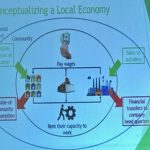
The morning session started with two presentations about Rural, Community and Economic Development and Strategic Planning. We were introduced to two developmental models, the people and place-based policy while focusing on rural areas in the South and how politics, history, social and economic dynamics of the South have impacted the region. Rural places make up less than 30% of the US hence these areas have had less benefit and less voice in shaping national policies compared to urban areas. From a historical economic perspective, agriculture has been the major driver with labor and skill offered cheaply by enslaved Africans and later shifting the African Americans into low cost, low skill labor manufacturing – thus successfully maintaining persistent poverty in the region since 1930. To help reduce this problem, government needs to create policies that are more people based in order to develop the individual by developing the skill set of rural America. Also, we were encouraged to take advantage of the global economy; produce locally and ship the goods across to the buyer and make a decent income.
While people-based policy focuses on residents that live there, place-base focuses on physical infrastructure and has historically been the policy adopted more in the US. With a top-down government structured approach, commissions such as the Appalachian, Denali, and Southeast Crescent lag behind where development based who and where decisions are made. The major cause of poverty comes from lack of adequate (effective) policy. Next, we discussed the topic of rural development and the numerous programs offered that are directed to individuals such as the homeownership and community facilities building. Programs in renewable energy systems, telecommunication, and broadband funding were also introduced. Noteworthy is the telemedicine grant which helps rural communities connect teacher, student and medical providers over distances. The rural development offices are in four regions (western region, north-central, northeast and southern) with 47 state offices and 400 area offices.
The part two of the strategic planning topic was a discussion of the type of development initiatives and programs. We looked into the enterprise zones and how these transitioned into opportunity zones. Next, we learnt that program participation Canada is highly impacted by distance and density which has influence on rurality. Accordingly, changes in the rural communities occurred with events that led to national building with rural as a resource bank; interventions with top down policies between 1950- 1980; reconstructing with neoliberalism and industrial flexibility between 1980 -2009; and lastly a negation period of winners and losers in post 2009. Local economic development and entrepreneurship relied on series of federal initiatives, hence the creation of jobs seizes as subsidies run out. Community futures Program (CFP) was needed at this time when LIP, LEAP and LEDA which depended on federal support had to be replaced with new strategy that is more community based with local priorities and community control. Thus, CFP started in 1985, private incorporated, not for profit organization and led by the community-based governance boards with key activities centered around business financing, business information and services, community strategic planning and CED projects and partnerships. There are 269 Community Futures in Canada in nearly all provinces and territories while targeting rural and northern communities. CFP has positively impacted these communities since information is available to the communities with respect to funds available for development and how funds are disbursed.
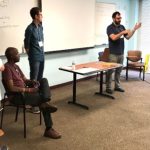
Then the third presenter took us across the ocean and there we saw that Europe has a large diversity rural development policy and is funded through the European agriculture fund for rural development with six priorities with fostering knowledge and innovation and promoting resources social inclusion as examples. It was implemented at local level by local communities to promote clear and transparent procedure. Also, cooperation, networking facilitating innovation and area based local development strategy are examples of features looked at with a bottom-up approach (unlike the US opportunity Zone which is a top-bottom approach with little or no community involvement in the decision making process).
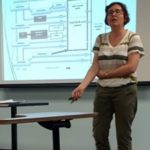
The afternoon session under the topic Agriculture Food Policies and Food Security, had two informative presentations. The first gave an enlightening video clip on food waste; definitions and differences between Loss (production) and Waste (throw away); and suggested some of the Loss/Waste potentials from production and harvest process through the consumption and restaurant phases. A high amount of food waste comes from the consumer – with a general lack of knowledge by the consumer and government food and safety regulation policies compounding the outcomes. Also of significance is the loss/waste of natural resources with unconsumed food including water, land use, the carbon footprint for fuel/pesticides/fertilizers, and operator money. This represents just the tip of the iceberg!
The next speaker presented the European Food Banks Federation (FEBA) program and it growing overall efforts to focus on food security while building capacity to adapt to new situations. While increasing operations and efforts in both the US and the UK, the FEBA is also continuing to focus on the importance to serve as co-operator; to continually improve fresh products; and to focus and continue to work with local social services for efficiency.
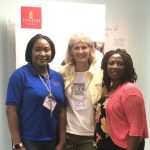
During the break Tuskegee students conducted ICRPS recording-clips and provided photo opportunities with some happy blog writers (as shown on the right).
ICRPS doesn’t only teach participants about book knowledge, they extend beyond that by providing hands-on demonstration of what is being taught in the classroom. After class we visited the Global Center for Post-harvest and Food Processing at Tuskegee University where ICRPS participants were engaged and exchanged information about the live and ongoing demonstrations and research. The TU post-harvest was established base on research within the US and Africa by faculty from the College of Agriculture to build TU’s long term capacity in post-harvest and food processing technology to help limited resource farmers in the Southeastern region of the US reduce farm loss. Food loss is more predominant in the developing world while food waste is more of a challenge in the developed countries from retail to consumption on the supply chain. The highest farm loss (46%) experienced by local farmers in the black belt is as a result of drought, but it is important for these farmers to understand cost benefit analysis if they have an idea of what their losses are and how best these farmers can add value to their left over farm produce.
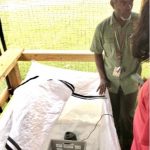
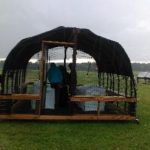

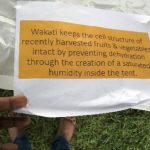
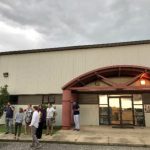
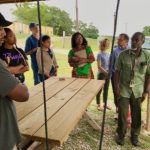
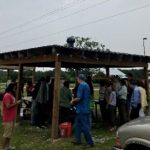
A little ‘hoops’ to finish the day by our energetic 2018 classmates!
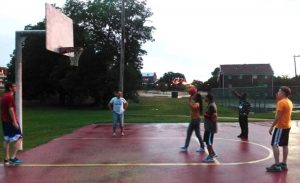
(Picture by Ana Paola)
Written by: Riikka Kangas, Jabeka Macklin, & Sandra Moore.
We started the day boarding a bus at the Kellogg Center at Tuskegee University and picking up a few local students at a gas station along the way. Once all of us were on board the bus we headed down Interstate 85 for a 45-minute drive to Montgomery.
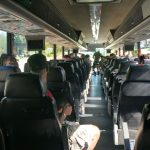
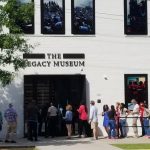
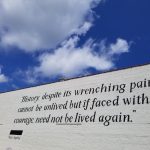
Our first stop was the Equal Justice Initiative Legacy Museum. This legacy museum opened in 2018 and shows the history of the injustice towards African Americans in the United States. From displays in the center we learned many astonishing facts such as that between 1820 to 1860 the population of slaves in Alabama rose from 41,879 to 435,080, that Alabama banned the presence of “free blacks” during slavery times, and after emancipation in 1863 there were still strong proponents of slavery such as Mississippi’s Governor who stated that “they (African Americans) are to be returned to a condition of serfdom. An era of second slavery”.
Many of us stated this was an emotional visit. Many felt that it was unbelievable that humans could treat other humans that way, or how it was possible that so many people could have committed these atrocities and how so many people could have followed such immoral thoughts. Many others also thought it was overwhelming to see things you already knew in such an honest, authentic manner, for example in the entrance hallway of the museum there was the portrayal of an auction block with holograms of slaves in holding cells before they were sold.
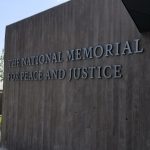
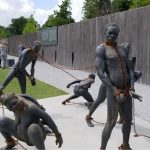
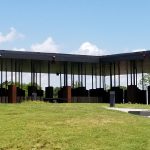
Our next stop was the National Memorial for Peace and Justice, a six-acre site overlooking Montgomery that is a memorial for the more than 4,400 African American men, women, and children who were killed by the terrorist act of lynching between 1877 and 1950.

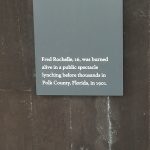

As you enter the site, you walk up an elevated path to the top of a hill where there are 800 steel monuments from each county where the lynching’s occurred throughout the United States. Each box was inscribed with the names (if known) and dates of the individuals who died. There was also a section describing why some of these people were lynched. The names of those known and unknown were verified by at least two written documents. Again, an emotional site to visit for the group.

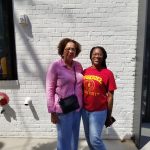
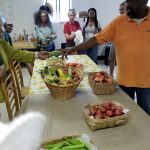
Boarding the bus again we headed back toward Tuskegee to visit the Al Hooks farm, a small processing farm, led by Demetrius Hooks and his dad Al Hooks. The farm processes and supplies various produce to local grocery stores and farmer’s markets.
Back on campus, we debriefed as a group on the day’s visits. One of the local participants, Kara, told us how our past connects to our present – she was able to confirm her own family history when she saw four of her relatives names at the Equal Justice Legacy Museum on the Community Remembrance Project Exhibit.
The final session of the day was Disparities, Race, and Social Justice. We had two presentations from faculty – Philomena De Lima led a discussion on intersecting identities, rurality and implications for rural policy and Wayne Kelly discussed community resilience and youth engagement. We concluded with an activity that made us realize that despite our differences we have many commonalities.
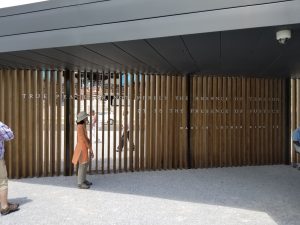
By Kara Woods and Emily Piontek
We started the second day of the conference by learning about different research methods. Going from general to specific, we discussed the universal linguistic relationships found in classifying natural observations within ethnoscience: taxonomy, patronomy, and queuing. After, more specific research methods were taught during breakout sessions. Sessions about Quasi Experimental Dialogue, Community Based Organizations, Data Sets and Key Informant Interviews introduced both qualitative and quantitative methods which help organize as well as analyze data. An important takeaway from the morning session was how much your specific research question directs the method used, questions asked, and informants interviewed. Another takeaway is the importance of united understanding when asking questions for research. During the session Robert Zabawa gave the example of finding farmers in West Africa that cultivated orange- fleshed sweet potatoes. Even though many farmers asserted they grew orange-fleshed sweet potatoes, none were found during farm visits. The conclusion was the different understanding of what the color orange entailed. When researching, common understanding and classification between researchers and research participants is imperative.
After lunch, ICRPS students and faculty members reconvened for an afternoon focused on the history of Tuskegee University itself, as well as the contextual history of racial injustice and inequality in the United States. Walter Hill of Tuskegee University presented on the history of land grant institutions such as Historically Black Colleges and Universities (HBCUs), and discussed the importance of continued advocacy for policies and funding that fairly support HBCUs. Jerry Pennick of the Federation of Southern Cooperatives presented on his work in developing relationships between community organizations and Tuskegee University. The Integrated Research & Extension program, which he administers, works to empower and support marginalized communities by connecting rural citizens to both resources and researchers at the university. Finally, Tuskegee archivist Dana Chandler discussed the impact made on Tuskegee University, and the scientific community at large, by George Washington Carver and his agricultural discoveries. Notably, Carver understood that “green agriculture”, or the use of agricultural products and processes to serve as energy sources, would one day supplant American dependence on oil.
ICRPS finished the afternoon with our first field trip away from campus. We rode through lush, verdant Alabama for a tour of the Tuskegee Airmen National Historic Site. The Tuskegee Airmen were the first African American members of the US Air Force, who overcame significant discrimination to become some of the finest fighter pilots of WWII. Their service paved the way for desegregation of the United States military. Our final stop was a visit to the Tuskegee Human and Civil Rights Multicultural Center. This museum portrays the US Public Health Service Study of Untreated Syphilis in the Male Negro, as well as the history of racial injustice in the United States. The US Public Health Service Study of Untreated Syphilis in the Male Negro, conducted between 1932-1972, was a federally sanctioned study in which hundreds of African American citizens were diagnosed with syphilis, yet left unaware of their condition. These men, never treated for the disease, were left to live untreated for the duration of their lives, even after a treatment for syphilis had been discovered. The presentations and field trip of the afternoon showed how far the United States has come in overcoming racial injustice, while emphasizing how much policy, development, and social justice work is left to be done.




Written by: Donna Davis, University of Missouri
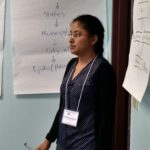 The 15th Annual International Comparative Rural Policy Studies (ICRPS) Summer Institute has started and everyone would agree hosted by a very accommodating, gracious, and friendly Tuskegee University faculty and campus student body. The theme this year ‘Social Justice, Rural and Natural Resource Policy’ follows ICRPS with the focus as identified in the syllabus on the policies and programs affecting small-scale, beginning minority and indigenous farmers, landowners and their communities.
The 15th Annual International Comparative Rural Policy Studies (ICRPS) Summer Institute has started and everyone would agree hosted by a very accommodating, gracious, and friendly Tuskegee University faculty and campus student body. The theme this year ‘Social Justice, Rural and Natural Resource Policy’ follows ICRPS with the focus as identified in the syllabus on the policies and programs affecting small-scale, beginning minority and indigenous farmers, landowners and their communities.
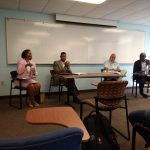 After welcomes by Thierno Thiam and Robert Zabawa, and introductions by the more than 20 students, we jumped into a lively engagement moderated by Judy Stallmann, University of Missouri, with government structure sharing from the students representing the various countries including Canada, Ghana, Nepal, Bangladesh, Nigeria, Jamaica, Trinidad & Tobago, France, Spain, Mexico, the United States, and others.
After welcomes by Thierno Thiam and Robert Zabawa, and introductions by the more than 20 students, we jumped into a lively engagement moderated by Judy Stallmann, University of Missouri, with government structure sharing from the students representing the various countries including Canada, Ghana, Nepal, Bangladesh, Nigeria, Jamaica, Trinidad & Tobago, France, Spain, Mexico, the United States, and others.
Thierno Thiam than introduced a 3-person guest speaker panel from local and state of Alabama governments Lawrence ‘Tony’ Haygood, Mayor of the City of Tuskegee; Andrew Thompson, Commissioner in Macon County, and Anita Archie, Alabama Department of Economic and Community Affairs.
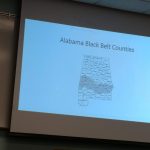 Ray Bollman, Brandon University and Robert Zabawa, Tuskegee University, opened presentations on ‘What is Rural?’ – including definitions of rural and rurality, rural policy, rural development, and rural indicators; introduced the Southern Black Belt counties in Alabama; and ended with the questions – Where does RURAL fit into the cause and effect equation? Is it a CAUSE? Or an OUTCOME? – Or does it matter? (Yes! – author note!).
Ray Bollman, Brandon University and Robert Zabawa, Tuskegee University, opened presentations on ‘What is Rural?’ – including definitions of rural and rurality, rural policy, rural development, and rural indicators; introduced the Southern Black Belt counties in Alabama; and ended with the questions – Where does RURAL fit into the cause and effect equation? Is it a CAUSE? Or an OUTCOME? – Or does it matter? (Yes! – author note!).
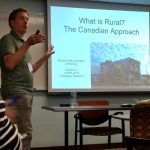 Country Examples of ‘What is Rural? were presented by Gabino Nava-Bernal, Universidad Autonoma del Estado de México for Mexico, Wayne Kelly for Canada, and Philomena De Lima for Scotland.
Country Examples of ‘What is Rural? were presented by Gabino Nava-Bernal, Universidad Autonoma del Estado de México for Mexico, Wayne Kelly for Canada, and Philomena De Lima for Scotland.
 A great special Tuskegee Achieves tour was given by Dana Chandler, Tuskegee University, with special kudos for Cheryl.
A great special Tuskegee Achieves tour was given by Dana Chandler, Tuskegee University, with special kudos for Cheryl.
What a great Day 1 completed with an afternoon rain shower!
